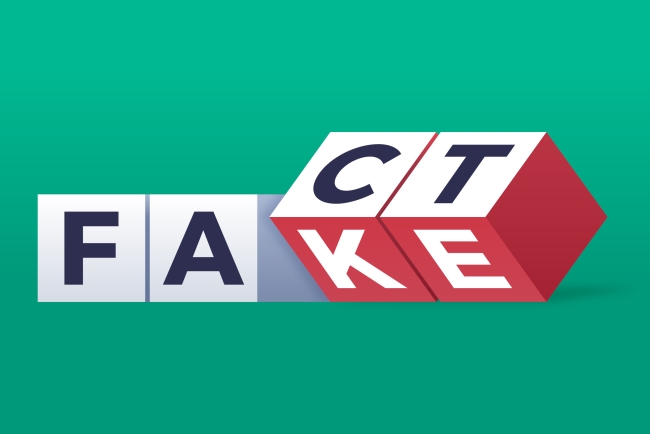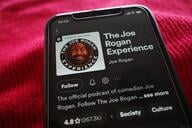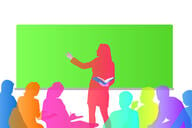You have /5 articles left.
Sign up for a free account or log in.

filo/DigitalVision Vectors/Getty Images
“How could this happen?!” “Who do you think Q is?” Those were two of the first questions students asked when a new class that I was teaching, CYB100 Infowars, began on Jan. 25, 2021.
Perhaps you are wondering how we had a course focused on disinformation literacy ready to go just 19 days after the assault on the U.S. Capitol Building. The short answer is that in 2018, my colleagues and I had conceived of a cybersecurity course focused on the ultimate hack—the intentional use of information to manipulate human behavior—and we’d gotten it approved in 2019.
The events of Jan. 6, 2021, simply highlighted the need for this course, at the same time impacting how I could teach it. With real outcomes on display for the world to see, I had to introduce course content in a way that was sensitive to the reality that at least a few of the students in the room had probably been down the Q rabbit hole. How could I get them back? How could I help our students develop the necessary skills to recognize misinformation and disinformation?
One year later, after two years of pandemic lockdowns and ongoing debates about masks and vaccines, I discovered that students were struggling to recognize legitimate information. During an assignment to bring in examples of pseudoscience—an easy assignment for 2021 students—more than half the class brought in op-eds from The New York Times written by esteemed academic researchers. Students did not agree with the scientific findings, so they classified them as disinformation.
Poor information, disinformation and media literacy skills are just one symptom of a much larger problem. Gen Z is living through some of the most volatile, uncertain, complex, ambiguous experiences the world has seen since the events leading up to World War II. They are also immersed in the virtual world, the effects of which we are only just beginning to understand. And they are experiencing all this while their brains are still developing.
They believe they are social-media savvy. They can describe the echo-chamber effect, but most fail to recognize when they are in an information silo. They care about freedom of expression, but they feel “unsafe” when confronted with ideas that are different from their own. They struggle with mental health challenges, and they have difficulty with sustained attention.
None of this is an accident. Information warfare is designed to thwart open dialogue. It is designed to stop us from thinking. It is designed to keep the population so stirred up that they cannot solve difficult social problems.
More than 30 years after the launch of the World Wide Web, locating and evaluating information has become exponentially more difficult. Information literacy is still a crucial skill, but while it is necessary, by itself it is insufficient. In addition to information literacy, we need to build disinformation literacy skills: a set of abilities to identify and evaluate misinformation, disinformation and malinformation, and to reduce their effect on cognitive load.
We are all surrounded by information vying for our attention at all hours of the day and night. It is virtually impossible to turn off the deluge. A device in our pocket is constantly alerting us to something that demands our immediate attention. Meanwhile, 24-hour news stations are screaming at us with alarming headlines.
What we are experiencing goes beyond information overload. We are all targets in multiple relentless information warfare campaigns, and our cognitive load is at an all-time high. I developed our CYB100 Infowars class not only to improve information and disinformation literacy skills, but also to help our students do more than survive in a world of information warfare—I want them to thrive!
Since 2019, websites have been developed to support teaching information literacy, media literacy and how to recognize misinformation and disinformation, but they are only addressing individual elements of the problem. The European Digital Media Observatory argues that media literacy is not only important for students, but for adults, as well. The Boston Public Library provides a blog post with examples of disinformation, and educators across higher ed are calling for programs in media literacy to fight disinformation. Yet despite broad recognition of a widespread social need, the course I developed for our students is distinct, taking a strategic approach that goes far beyond solely the recognition of disinformation.
This interdisciplinary course is divided into three five-week units: 1) the individual, 2) the information ecosystem and 3) the rivalry for power that occurs when people and information collide. At the heart of information operations is the intent to influence people’s decisions, which is why we begin in class with a deep understanding of how individuals perceive and process information for decision-making. The desire of human beings to share knowledge with each other leads naturally to the rise of an information ecosystem that leverages technology to expand the reach of storytelling.
In the second part of the class, we explore how technology and the media use the psychological concepts from the first unit to craft information and disinformation that captures attention and influences decisions. Finally, we explore what happens when people and information collide in a struggle for power, investigating everything from the lucky socks an athlete refuses to wash to the power of cults and the use of propaganda to control populations.
One of my students described his experience in the class this way: “I can understand a lot better the consequences of misinformation, how knowledge is power and how to exploit this or recognize that it is being exploited on me. I think with the popularity of social media on the rise, and maybe even at its highest, everyone should take a class like this, because they really do not understand the implications of some things on those platforms.”
I took my students’ advice. They had input into the content of the textbook. They identified the concepts that helped them to improve their attention, their information and disinformation literacy, and coping skills for supporting their mental health. My colleagues and I also listened when this student and others suggested, “Everyone should take a class like this.” In fact, we just expanded this cybersecurity course to the entire business school, recognizing that the ability to recognize legitimate information in a polluted environment is a foundational skill for every profession.
Information warfare is a rivalry for power, shaping everything from geopolitics to business to the classroom, and we are all targets. By teaching our students to recognize information strategies and their effect on attention, cognitive stress and decision-making, we are equipping them to thrive in our increasingly complex, constantly changing world and win the information warfare battles.




